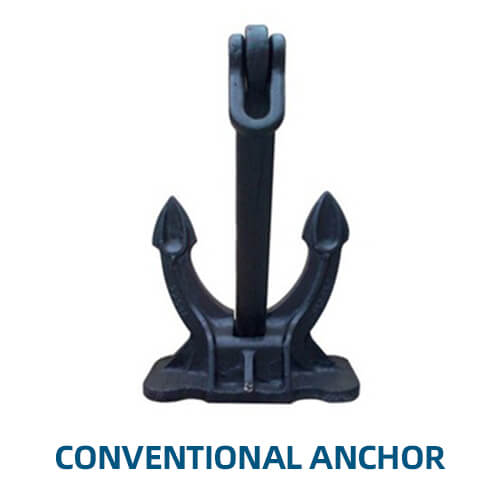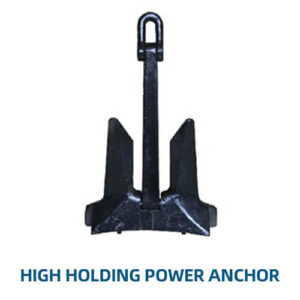Types of Conventional Anchor:
-
Admiralty Anchor (Fisherman’s Anchor):
- Design: The Admiralty anchor is one of the oldest and most recognizable anchor designs. It has a long shank with a crossbar (stock) at the top and two large, pointed flukes at the bottom.
- Use: It is particularly effective on rocky or hard seabeds, where the flukes can dig in and hold securely. However, it is less effective in sandy or muddy conditions.
- Advantages: The Admiralty anchor is known for its strong holding power in challenging conditions. It is still used today on some smaller boats, inshore applications, and as a decorative symbol of maritime tradition.
- Disadvantages: The anchor’s design makes it bulky and difficult to stow.
-
CQR (Plow) Anchor:
- Design: The CQR anchor, also known as a plow anchor, has a hinged, plow-shaped design that allows it to pivot and maintain a stronghold as the boat shifts with wind or current changes.
- Use: It performs well in a variety of seabed types, including sand, mud, and gravel, making it a reliable choice for general use.
- Advantages: The CQR anchor can reset itself if the wind or current changes direction.
- Disadvantages: It can be less effective in very soft or weedy seabeds, where it may not dig in as deeply.
-
Danforth Anchor (Fluke Anchor):
- Design: The Danforth anchor features two wide, flat flukes that pivot on a single shank. The design allows the flukes to dig deeply into sandy or muddy bottoms, providing strong holding power.
- Use: It is especially effective in soft seabeds, such as sand and mud, but may not perform as well on rocky or weedy bottoms.
- Advantages: The Danforth anchor is lightweight and provides excellent holding power relative to its size. It is also easy to stow due to its flat design.
- Disadvantages: It may struggle to reset itself if the boat’s direction changes, and it can be less effective on hard or rocky seabeds.
General Features of Conventional Anchor:
- Holding Power Conventional Anchors: Conventional anchors dig into the seabed. Therefore creates a resistance against the pull of the vessel, providing a secure hold.
- Material of Conventional Anchors: They are made using galvanized steel, stainless steel, or other materials for durability and corrosion resistance.
- Size and Weight of Conventional Anchors: The size and weight of the anchor are important factors in its effectiveness. Heavier anchors generally provide better holding power but may be more difficult to handle.
Considerations for Choosing a Conventional Anchor:
- Seabed Conditions: The type of seabed where you plan to anchor most frequently will influence the type of anchor you choose. For example, a Danforth anchor is ideal for sandy bottoms, while a CQR might be better for mixed conditions.
- Vessel Size: The size and weight of the anchor should ensure adequate holding power.
- Ease of Storage: Some conventional anchors, like the Danforth, are easier to stow due to their flat design, while others, like the Admiralty, may require more space.
Conventional anchors remain a popular and reliable choice for many boaters due to their proven designs and effectiveness in various conditions. Conventional Anchor is a staple in marine anchoring, offering simplicity, durability, and dependable performance.






